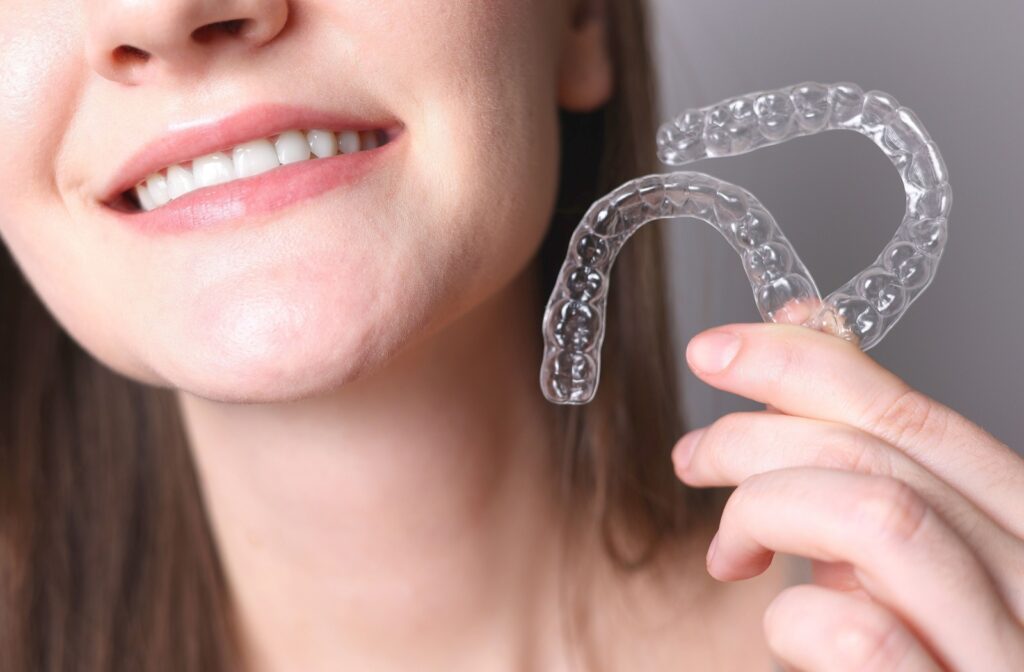Dental care plays a crucial role in oral health and overall well-being. Some people might even have smile goals. But when considering treatment for straightening teeth, the debate between Invisalign and traditional braces often arises.
So, is Invisalign better than braces? There isn’t a yes or no answer. It usually depends on the degree of misalignment, cost, preference, and your dentist’s recommendations. Exploring the differences, benefits, and considerations of both Invisalign and braces can help you make an informed decision.
What is Invisalign and How Does it Work?
Invisalign is a modern approach to teeth straightening using clear, removable aligners. These aligners are custom-made for each patient, gradually shifting the teeth into the desired position. One of the significant benefits of Invisalign is its nearly invisible appearance, making it a popular choice among adults and teenagers who prefer a discreet treatment option.
Invisalign are clear, custom-fit plastic aligners that fit snugly over the teeth. The wear time for Invisalign aligners is 22 hours daily. While Invisalign offers many advantages, it can also have limitations, particularly in treating more complex dental issues.
How to Care for Invisalign Aligners?

Traditional braces include brackets and wires that can break and require more frequent dental visits. Each Invisalign aligner consists of one solid piece and are removable, making caring and cleaning them easier. Here is how you can care for Invisalign aligners:
- Always remove them when eating or drinking.
- Brush your teeth or rinse your mouth after eating or drinking, and before putting your aligners back in your mouth.
- When not in use, store aligners in a protective case.
- Clean aligners every day as directed by your dentist.
What are Braces and How Do They Work?
Traditional braces have been the go-to solution for teeth straightening for decades. They consist of metal brackets bonded to the teeth and connected by wires and rubber bands. These components work together to apply continuous pressure, gradually moving the teeth into the correct alignment.
Braces are highly effective in treating various dental problems, from minor crowding to severe misalignment. However, they can come with challenges such as discomfort, dietary restrictions, and noticeable appearance. Despite these drawbacks, braces remain a reliable and widely used orthodontic treatment.
Is Invisalign Better Than Braces?
It’s important to consult with your dentist to determine if Invisalign is the right option for you. There are several reasons why Invisalign may be better than braces for an individual:
- Invisalign is highly effective for treating mild to moderate dental issues, such as overcrowding, gaps, and minor bite problems.
- The aligners are precisely engineered using advanced 3D imaging technology, allowing for a customized treatment plan tailored to each patient’s needs.
- The clear aligners are virtually invisible, allowing patients to straighten their teeth without drawing attention to their orthodontic treatment.
- Invisalign aligners are designed with comfort in mind. The smooth plastic material reduces the risk of irritation to the cheeks and gums, and the absence of metal components means fewer adjustments and discomfort.
- Maintaining Invisalign aligners is relatively simple. The convenience of removing the aligners for meals and oral care makes Invisalign a popular choice for those seeking flexibility in their orthodontic treatment.
- The cost of Invisalign treatment varies depending on the complexity of treatment and the duration of treatment. Some dental insurance plans may cover a portion of the cost, but it’s essential to check with your provider for specific coverage details.
Regular check-ups with the orthodontist ensure the treatment progresses as planned, with new aligners provided every few weeks.
Decision-Making Factors
When choosing between Invisalign and braces, consider several factors, such as:
- The severity of dental issues: Invisalign is best suited for mild to moderate cases, while braces are more effective for complex dental problems.
- Aesthetic preferences: If appearance is a primary concern, Invisalign’s clear aligners offer a discreet option, while braces are more noticeable.
- Comfort and convenience: Invisalign aligners are removable and generally more comfortable, while braces require more maintenance and may cause discomfort.
- Budget: Consider the cost of treatment, insurance coverage, and available financing options.
Consulting with Your Dentist
The best way to determine the most suitable treatment is to consult your dentist. They can assess your dental needs, discuss treatment options, and provide personalized recommendations. It’s essential to ask questions, understand the pros and cons of each option, and make an informed decision based on your unique circumstances.
Transform Your Smile with Invisalign
In the debate between Invisalign and braces, there is no one-size-fits-all answer. Both options have advantages and limitations, and the best choice depends on individual preferences, dental needs, and lifestyle considerations.
By understanding the differences and benefits of each treatment, you can make a well-informed decision that aligns with your goals for a healthy and beautiful smile. The first step towards achieving your dream smile is to consult a dental professional. Book an appointment with Sundance Dental Clinic today.





